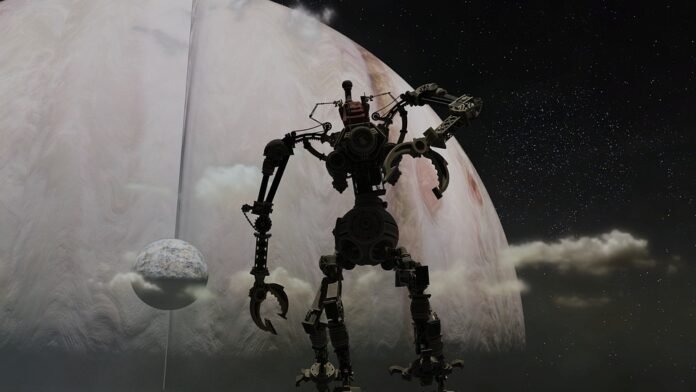Here is an article about the Uncanny Valley.
The Uncanny Valley: Why Life-Like Robots Still Give Us the Creeps
You’re watching a movie with cutting-edge animation. A character on screen looks almost perfectly human—the skin texture is right, the hair moves naturally. But something is off. The eyes seem vacant, the smile doesn’t quite reach them, and a subtle stiffness in their movement sends a shiver down your spine. Instead of feeling impressed, you feel a distinct sense of unease.
Or perhaps you’ve seen a video of a new humanoid robot. It can hold a conversation and mimic facial expressions with startling accuracy. Yet, the closer it gets to looking human without achieving perfection, the more it repels you.
If you’ve ever felt this strange, specific revulsion, you’ve tumbled into the Uncanny Valley. It’s a fascinating psychological phenomenon that explains why we’re more comfortable with a friendly, beeping droid like R2-D2 than with an android that’s almost indistinguishable from a person.
What Exactly is the Uncanny Valley?
The concept was first introduced in 1970 by Japanese robotics professor Masahiro Mori. He proposed that as a robot’s appearance is made more human-like, our emotional response to it becomes increasingly positive and empathetic. A simple industrial robot arm is neutral. A cute, toy-like robot like Wall-E elicits affection.
But this positive feeling doesn’t increase indefinitely. According to Mori, just before the point of perfect human likeness, our affinity takes a sharp, sudden plunge. This deep chasm of revulsion and strangeness is the Uncanny Valley. Once the likeness becomes so perfect that the robot or animation is indistinguishable from a healthy human, our positive feelings return.
Think of it as a graph of familiarity versus comfort. As familiarity increases, so does our comfort—until that tipping point where “almost human” becomes “eerily inhuman.” Classic examples in pop culture include the characters from the 2004 film The Polar Express or the early attempts at realistic CGI in Final Fantasy: The Spirits Within. They were technologically ambitious, but their “dead-eyed” characters left many viewers feeling deeply unsettled.
Why Do We Experience This? The Theories Behind the Creeps
Scientists and psychologists don’t have one definitive answer for why the Uncanny Valley exists, but several compelling theories offer explanations.
1. Pathogen and Mate Avoidance:
This evolutionary theory suggests that the Uncanny Valley is a defense mechanism. A creature that looks almost human but has subtle flaws—asymmetrical features, jerky movements, or a pallid complexion—triggers an ancient, instinctual alarm in our brains. These are signs that might indicate disease, genetic defects, or even death. Our subconscious screams, “Stay away! That thing is not healthy.” The feeling of revulsion is a primal instinct to avoid potential contamination or a poor choice of mate.
2. Cognitive Dissonance and Category Violation:
Our brains are powerful sorting machines. We have a mental category for “human” and another for “robot” or “doll.” When something appears that doesn’t fit neatly into either box, it creates a sense of mental conflict, or cognitive dissonance. Is it alive or not? Is it a person or an object? This ambiguity is deeply unsettling because our brains can’t resolve the paradox. The entity looks human but lacks the subtle cues of genuine life—the micro-expressions, the natural rhythm of breathing, the spark of intention in the eyes. This violation of our established categories makes us deeply uncomfortable.
3. A Threat to Our Human Identity and Mortality:
When we see an android that blurs the line between man and machine, it can trigger profound existential anxieties. It forces us to confront the idea that we, too, are essentially biological machines. A near-perfect android serves as a stark reminder of our own mortality—it looks like us but is lifeless, almost like a walking corpse. Furthermore, it challenges our sense of human uniqueness. If a machine can look and act so much like us, what does it truly mean to be human? This perceived threat to our identity can be deeply disturbing.
Navigating and Escaping the Valley
Designers, animators, and roboticists are acutely aware of this challenge. They generally employ two strategies to deal with it:
-
Stay Out of It: The safest route is to create robots and characters that are clearly not human. By stylizing them, we remove the ambiguity. This is why characters like Baymax from Big Hero 6 or the droids from Star Wars are so beloved. They are expressive and relatable without ever pretending to be human, keeping them firmly on the “safe” side of the valley.
-
Cross It Completely: The other, far more difficult, strategy is to push through the valley to the other side. This requires achieving such a high level of realism that the artificial nature of the creation is undetectable. Modern CGI has come incredibly close, with digital characters in films like Avatar: The Way of Water and Blade Runner 2049 successfully crossing the chasm for many viewers. In robotics, however, this remains the holy grail—a feat not yet fully achieved.
The Future is Almost Human
As artificial intelligence becomes more sophisticated and robotics technology advances, we will inevitably spend more time interacting with creations that live in and around the Uncanny Valley. From AI customer service avatars to robotic companions for the elderly, the push for human-like machines will continue.
The Uncanny Valley is more than just a theory about creepy robots; it’s a mirror reflecting our own psychology. It reveals our deepest instincts about life and death, our need for clear categories, and our complex relationship with what it means to be human. The next time a life-like android gives you the chills, know that you’re not just reacting to a machine—you’re reacting to one of the most profound and mysterious quirks of the human mind.

